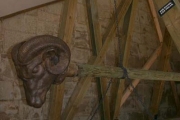Viewings: 5322

"...We found geological data, which, obviously, will lead directly to archaeological discoveries," said Dr. Roald Maxwell at the University of Washington. Dr. Maxwell, Dr. Harold Made and Virginia Steen Makinia reported at the annual meeting of the geological society of America that at the bottom of the stream in Mexico, they found intricate stone tools...
The problem is that these tools were much more sophisticated than those used in Europe and Asia, two hundred and fifty thousand years ago, the most simple of them were similar to those that were applied in the Old World thirty - five to forty thousand years ago. There are many credible evidence that the principles used in the XX century techniques have been known for a very, very long time.
Gynecology was practically unknown to science until the second half of the XIX century. October 20, 1900, "scientific American" reported that the excavations in Pompeii testify that gynecology is a "re-made the discovery in the world of surgery". Found in the Temple vestals tools, buried there after the eruption of Vesuvius in the first century ad, saying that gynaecology as science flourished in antiquity, then used tools is an exact duplicate those used in modern science. They made just fine, as their counterparts of the XX century.
Ancient Greeks built steam boilers, but used them only as trinkets and not practical sources of power. On Easter Sunday 1900 Greek diver sponges from the island of Antikythera pulled from the sea bottom ugly bronze wonder. In 1958, Dr. Derek Solara recognized her mechanism equally amazing that the jet plane in the tomb of Pharaoh Tutankhamun. This tool with a complex set of devices and gear wheels was an accurate model of the Earth, Sun, moon, and planets, and perhaps was used to calculate the orbits of the planets. "Is weird when you know that just before the fall of their great civilization of the ancient Greeks came so close to our time, not only in the development of thought, but also in science and technology," wrote Dr. Price in "scientific American" in June 1959.
The Wright brothers, two lover, stubbornly demonstrated flight, driven by the engine is heavier than air. And this is after scientists, mathematicians proved the impossibility of carrying out such a mission. In ancient literature of the East, there are many hints that aviation was known in India as early as 500 B.C. In the sacred books of India referred to the "flying carriages and air bombs. Chinese myths narrate about legendary people Chi-Ki, who traveled in "the air crews." In "the Chronicles of scientists said that the great astronomer and engineer-Han-Chang Heng created a wooden apparatus with the mechanism inside, with which it was possible to fly over a kilometre. It seems that in the book written about 320 year To Huinga alchemist and a mystic, describes propeller: "Were made a flying chariot, the internal part of which was made of wood skirt with leather straps attached to the rotating blades To bring the mechanism in motion".
Electric batteries used more than two thousand years ago, long before Volts and Galvani. Dr. William Koenig, German archaeologist, visiting a Museum Haran in Baghdad, carrying out excavations of the South-East of Baghdad, found electrochemical batteries. The Central elements included copper cylinder containing iron rod. It seems that stem rust in the result of chemical reaction. The cylinder was soldered lead-tin alloy. The same alloy is used in our day. The electrolyte was withered by time. Engineer Willard gray made an exact copy of these elements, using as electrolyte copper sulphate.
For centuries, the sanitary situation in Europe was horrifying. The lack of an organized treatment contributed to the spread of the plague, which devastated the continent several times. However, for five thousand years ago in the valley of the Tigris near Baghdad in tel Asmara existed houses and temples with an elaborate system of sanitary-hygienic equipment. In one of the excavated temples there were six toilets and five bathrooms with running sistemoi connected with drainage (fanboy pipe, a system of canals, which was sewer pipe one meter in height and length of fifty metres). Exploring one sewer pipe, archeologists found a clay pipe. One end of each pipe in diameter was eight inches (twenty centimeters), and the other was reduced to seven inches, so that the tubes can be inserted one into another just as sewer pipes in the XX century.
Those who laugh over the idea that prehistoric man could not perform a more complex process than to RUB two sticks about one another, to make a fire, it is necessary to think over an article that appeared in the new York Herald tribune, February 16, 1947. ...When in new Mexico exploded the first atomic bomb, sand deserts turned into green glass melted. This fact was very important for archaeologists. Making excavations in the valley of the Euphrates, scientists have discovered a layer of agricultural crops by age eight thousand years and a layer of cattle-breeding culture even more ancient chronology, as well as traces of culture caveman. After a time, was discovered another layer of molten green glass. It happens that the sand melts lightning, but then melted areas have distinct root-like outgrowths branching form. Could anything other than a nuclear explosion, producing a layer of molten green glass.
















